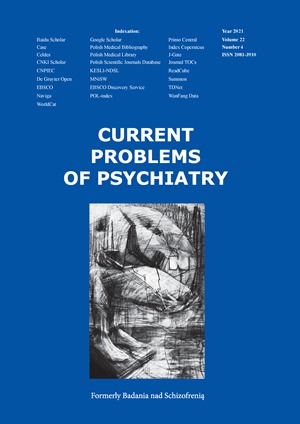The interaction between stress and metabolic disruption in studentpopulation – preliminary study
DOI:
https://doi.org/10.2478/cpp-2021-0022Keywords:
bioelectrical impedance analysis, obesity, students, mental health, stressAbstract
Introduction. Approximately 26% of individuals between 18 and 24 years old are overweight or obese, and the number of persons with excessive body mass index (BMI) is growing. Obesity increases the risk of metabolic disruptions, which is well connected with mental health problems. Stressful situations, including entering adulthood and starting university education, affect food choices negatively. The aim of the study was to examine the relationship between psychological stress and body composition in the student population.
Materials and methods. The study group consisted of 80 students (76% of women and 24% of men) between 19 and 28 years old from universities in Lublin. To determine anthropometric measurement (fat-free mass (FFM), fat mass (FM), total body water (TBW), intracellular (ICF) and extracellular (ECF) fluids), bioelectrical impedance analysis (BIA) method was applied. The severity of stress symptoms was measured using Perceived Stress Scale (PSS-10).
Results. When it comes to 41.25% of participants, they used relaxation techniques, mainly meditation, yoga practice and walking. Most students had optimal body weight. While 60% of individuals had high stress levels. The perceived stress was not related to using the relaxation methods. Individuals with the high stress severity were characterized by lower: TBW, ECF and ICF expressed in liters, and lower FFM represented in kilograms. The inverse relationship between the severity of stress and the aforementioned parameters was also detected (p<0.05).
Conclusions. Implementing appropriate health education programs to prevent negative changes in anthropometric measurements, psychological stress, and their health-related consequences in the student population should be considered.
References
1. Narodowy Test Zdrowia Polaków - Medonet.Pl Available online: https://www.medonet.pl/narodowy-test-zdrowiapolakow,kategoria.html (accessed on 25 January 2022).
2. Oddy, W.H.; Allen, K.L.; Trapp, G.S.A.; Ambrosini, G.L.; Black, L.J.; Huang, R.-C.; Rzehak, P.; Runions, K.C.; Pan, F.; Beilin, L.J.; et al. Dietary Patterns, Body Mass Index and Inflammation: Pathways to Depression and Mental Health Problems in Adolescents. Brain, Behavior, and Immunity 2018, 69, 428-439, https://doi.org/10.1016/j.bbi.2018.01.002.
3. Relationships between food consumption and living arrangements among university students in four European countries - A cross-sectional study. Nutrition Journal | Full Text Available online: https://nutritionj.biomedcentral.com/articles/10.1186/1475-2891-11-28 (accessed on 25 January 2022).
4. Ceccato, F.; Lizzul, L.; Barbot, M.; Scaroni, C. Pituitary-Adrenal Axis and Peripheral Cortisol Metabolism in Obese Patients. Endocrine 2020, 69, 386–392. https://doi.org/10.1007/s12020-020-02392¬4.
5. Misiak, B.; Łoniewski, I.; Marlicz, W.; Frydecka, D.; Szulc, A.; Rudzki, L.; Samochowiec, J. The HPA Axis Dysregulation in Severe Mental Illness: Can We Shift the Blame to Gut Microbiota? Progress in Neuro-Psychopharmacology and Biological Psychiatry 2020, 102, 109951. https://doi.org/10.1016/j.pnpbp.2020.109951.
6. World Medical, A. World Medical Association Declaration of Helsinki: Ethical Principles for Medical Research Involving Human Subjects. Jama 2013, 310, 2191.
7. Cohen, S.; Kamarck, T.; Mermelstein, R. A Global Measure of Perceived Stress. Journal of health and social behavior 1983, 385-396.
8. International Standards for Anthropometric Assessment. Available online: https://repository.openpolytechnic.ac.nz/handle/11072/1510 (accessed on 25 January 2022).
9. Perceived Stress Correlates with Visceral Obesity and Lipid Parameters of the Metabolic Syndrome: A Systematic Review and Meta-Analysis -ScienceDirect Available online: https://www.sciencedirect.com/science/article/pii/S030645301731586X ?casa_token=sz2p_BJ_kXcAAAAA:2kzuyW4MXzp6y0B3YP54htGdqcPwxwzHLQEM qKuIFzfx_G1R4dJZaJz7pQANfiVQXs5C-FHBww (accessed on 25 January 2022).
10. Karakula-Juchnowicz, H.; Rog, J.; Juchnowicz, D.; Łoniewski, I.; Skonieczna-Żydecka, K.; Krukow, P.; Futyma-Jedrzejewska, M.; Kaczmarczyk, M. The Study Evaluating the Effect of Probiotic Supplementation on the Mental Status, Inflammation, and Intestinal Barrier in Major Depressive Disorder Patients Using Gluten-Free or Gluten-Containing Diet (SANGUT Study): A 12¬Week, Randomized, Double-Blind, and Placebo-Controlled Clinical Study Protocol. Nutr J 2019, 18, 50. https://doi.org/10.1186/s12937¬019-0475-x.
11. Jaffrin, M.Y.; Morel, H. Body Fluid Volumes Measurements by Impedance: A Review of Bioimpedance Spectroscopy (BIS) and Bioimpedance Analysis (BIA) Methods. Med Eng Phys 2008, 30, 1257-1269, doi:10.1016/j.medengphy.2008.06.009.
12. Total Body Water and Intracellular Water Relationships with Muscle Strength, Frailty and Functional Performance in an Elderly Population. A Cross-Sectional Study | SpringerLink Available online: https://link.springer.com/article/10.1007/s12603-018-1129-y (accessed on 25 January 2022).
13. Increased Extracellular Water Measured by Bioimpedance Analysis and Increased Serum Levels of Atrial Natriuretic Peptide in Polymyalgia Rheumatica Patients | SpringerLink Available online: https://link.springer.com/article/10.1007/s00393-020-00845-9 (accessed on 25 January 2022).
14. Wee, B.S.; Aryati, A.; Karimah Fakhriah, I. Association between Stress, Physical Activity and Body Composition among Adults in Terengganu.; Kuala Lumpur, 2018.
15. Full Article: Association of Body Fat with Stress Levels and Dietary Intakes in Indian Women Available online: https://www.tandfonline.com/doi/full/10.1080/03630242.2018.1539429 (accessed on 25 January 2022).
16. Change in Weight and Adiposity in College Students: A Systematic Review and Meta-Analysis-ScienceDirect Available online: https://www.sciencedirect.com/science/article/pii/ S0749379714004024?casa_token=lAWtyEA5mVgAAAAA:65cdf SF6NakS8UZZ7QahuVgq-T2Wfj6QRtkGCwhnpM2FaTB4zyS0jw m3vbdmONzJ2_rSwE6ZHg (accessed on 25 January 2022).
17. Legey, S.; Lamego, M.K.; Lattari, E.; Campos, C.; Paes, F.; Sancassiani, F.; Mura, G.; Carta, M.G.; Rocha, N.B.F.; Nardi, A.E.; et al. Relationship Among Body Image, Anthropometric Parameters and Mental Health in Physical Education Students. Clin Pract Epidemiol Ment Health 2016, 12, 177-187. https://doi.org/10.2174/1745017901612010177.
18. Jakubowska, L.; Grabowska, B.; Seń, M. PHYSICAL ACTIVITY, HEALTH CONDITION AND LIFESTYLE OF ACADEMIC YOUTH. Journal of Education Culture and Society 2019, 10, 201-215. https://doi.org/10.15503/jecs20192.201.215.
19. Borghi, F.; Rocha-Teles, C.M.; McFadden, S.K.; da Silva, P.C.; Souza, A.L.; Grassi-Kassisse, D.M. The Influence of the Academic Exams Routine on the Perceived Stress, Resilience and Salivary Cortisol in Brazilian Pharmacy Undergraduate Students. Personality and Individual Differences 2021, 179, 110928. https://doi.org/10.1016/j.paid.2021.110928.
20. The Effect of the Menstrual Cycle on Body Composition Determined by Contact-Electrode Bioelectrical Impedance Analyzers Available online: https://www.ncbi.nlm.nih.gov/pmc/articles/PMC5841670/ (accessed on 25 January 2022).
Downloads
Published
Issue
Section
License
Copyright (c) 2021 Authors

This work is licensed under a Creative Commons Attribution 4.0 International License.


